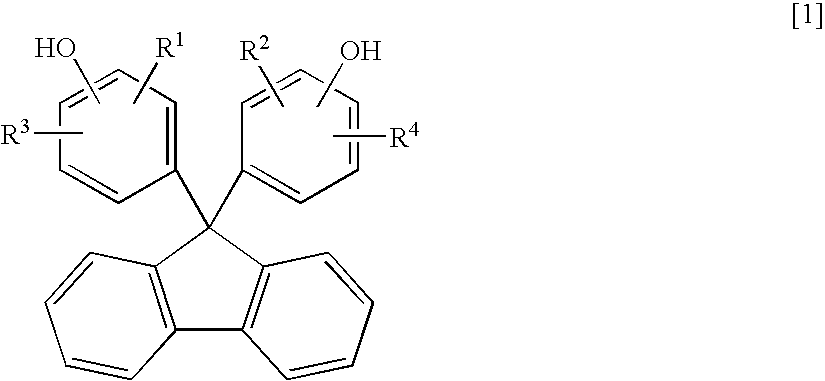Polycarbonate copolymer, resin composition, and molded article
a polycarbonate and resin technology, applied in the field of polycarbonate copolymer, resin composition and molded article, can solve the problems of insufficient heat resistance, heat resistance, and ordinary polycarbonate resin obtained from bisphenol a, and achieve good heat resistance and birefringence, and improve color.
- Summary
- Abstract
- Description
- Claims
- Application Information
AI Technical Summary
Benefits of technology
Problems solved by technology
Method used
Image
Examples
example 1
[0148]To a reactor equipped with a thermometer, agitator and reflux condenser, 190,500 parts of ion exchanged water and 105,400 parts of 25% sodium hydroxide solution were added. After 20 minutes after 43,560 parts of 9,9-bis(4-hydroxy-3-methylphenyl)fluorene (hereinafter may be abbreviated as “BCF” or “biscresol fluorene”) having a fluorene-9-one content measured by the above HPLC analysis of 2.1 ppm, 11,260 parts of 2,2-bis(4-hydroxyphenyl)propane (hereinafter may be abbreviated as “BPA” or “bisphenol A”) and 110 parts of hydrosulfite were dissolved, 178,400 parts of methylene chloride was added. Thereafter, under agitation, 22,810 parts of phosgene was blown into the mixture at 15 to 25° C. for 60 minutes. After completion of phosgene blowing, a solution prepared by dissolving 222.2 parts of p-t-butylphenol in 3,300 parts of methylene chloride and 13,200 parts of 25% sodium hydroxide solution were added. After emulsification, 40 parts of triethylamine was added, and the resulting...
example 2
[0149]A polymer 20% solution showing a molar ratio between biscresol fluorene and bisphenol A constituents of 60:40 was obtained (polymer yield: 98%) in the same manner as in Example 1 except that the amount of biscresol fluorene was 37,200 parts and the amount of bisphenol A was 15,000 parts. This polymer had an intrinsic viscosity of 0.709 and a Tg of 218° C. The content of fluorene-9-one in the obtained polymer was 2.1 ppm. A film having a thickness of 200 μm was obtained from this polycarbonate solution in the same manner as in Example 1. Casting film formability was good, and this film had a b value of 0.5.
example 3
[0150]A polymer 20% solution showing a molar ratio between biscresol fluorene and α,α′-bis(4-hydroxyphenyl)-m-diisopropylbenzene (hereinafter may be abbreviated as “BPM” or “bisphenol M”) constituents of 70:30 was obtained (polymer yield: 97%) in the same manner as in Example 1 except that 17,089 parts by weight of bisphenol M was used in place of bisphenol A. This polymer had an intrinsic viscosity of 0.671 and a Tg of 209° C. The content of fluorene-9-one in the obtained polymer was 2.4 ppm. A film having a thickness of 200 μm was obtained from this polycarbonate solution in the same manner as in Example 1. Casting film formability was good, and this film had a b value of 0.6.
PUM
| Property | Measurement | Unit |
|---|---|---|
| mol % | aaaaa | aaaaa |
| mol % | aaaaa | aaaaa |
| mol % | aaaaa | aaaaa |
Abstract
Description
Claims
Application Information
 Login to View More
Login to View More - R&D
- Intellectual Property
- Life Sciences
- Materials
- Tech Scout
- Unparalleled Data Quality
- Higher Quality Content
- 60% Fewer Hallucinations
Browse by: Latest US Patents, China's latest patents, Technical Efficacy Thesaurus, Application Domain, Technology Topic, Popular Technical Reports.
© 2025 PatSnap. All rights reserved.Legal|Privacy policy|Modern Slavery Act Transparency Statement|Sitemap|About US| Contact US: help@patsnap.com



